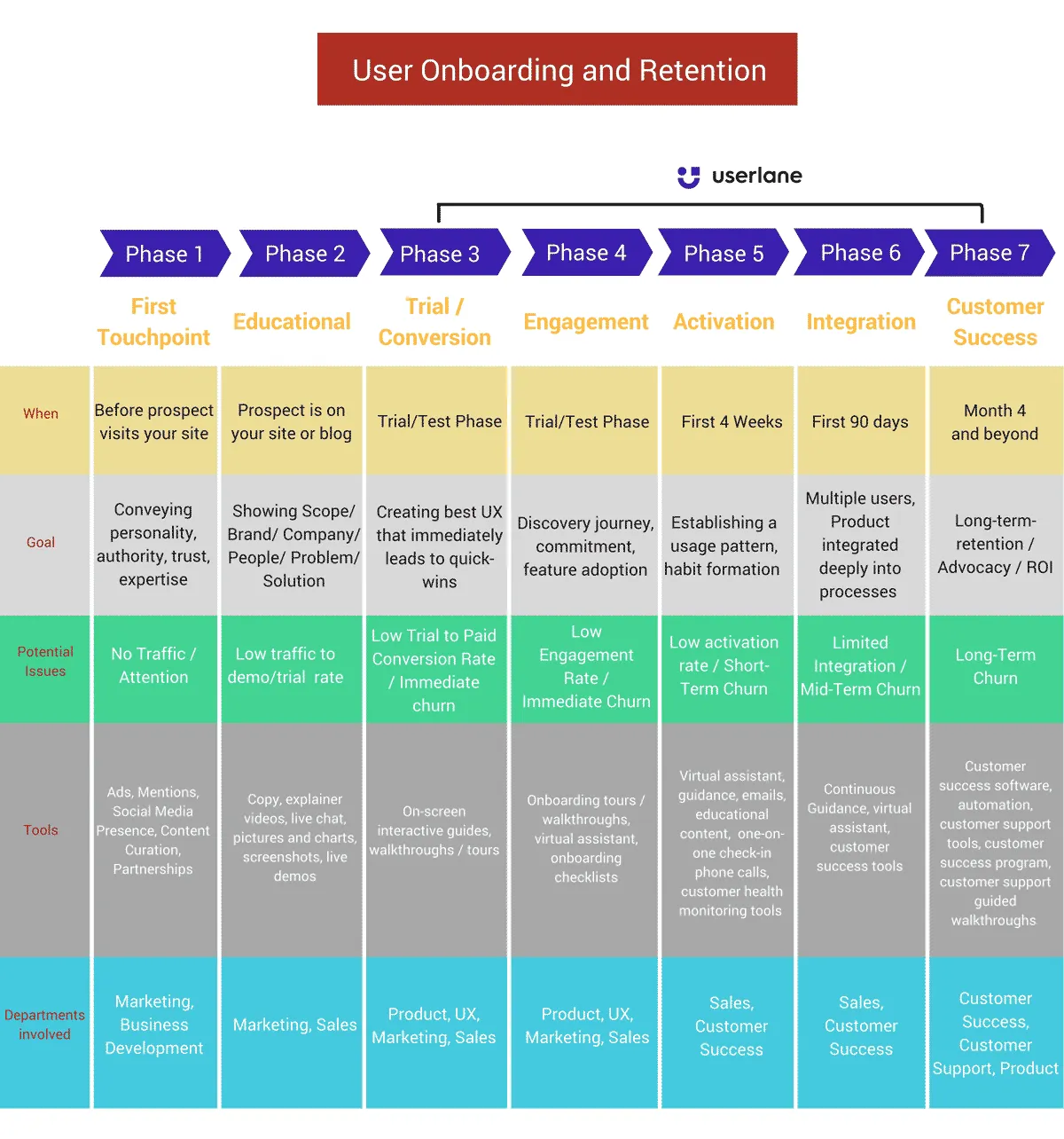Home  Digital Transformation and Digital Adoption
Digital Transformation and Digital Adoption  User Onboarding Steps That Can Make or Break Your Business
User Onboarding Steps That Can Make or Break Your Business
Digital Transformation and Digital Adoption
User Onboarding Steps That Can Make or Break Your Business

by
Team Userlane
8 years ago ・ 7 min.- The problem you’re addressing with your solution
- How you approach the issue
- Why your solution works
- The benefits of your product
- What your brand stands for
- How your product works
- How to achieve short term goals in the fastest possible why
- How to integrate your product in a long-term strategy
- How to become super proficient within your platform
- How to integrate your product within a complex ecosystem that includes several other software solutions
- How to measure success
- High Engagement
- Retention
- Customer Success
- Advocacy
Table of Contents
The More You Know the More You Understand
I don’t know about you, but I tend to fall in love with something the more I know about it. Say you watch a movie you like. Then you do some research and you discover a lot of insights into the plot, photography, actors, filming, symbolism, and a lot of other choices that the filmmakers made when writing or producing the movie… You go from liking it to loving it and talking about it with all your friends. The same might happen with a piece of music, a painting, a photograph, a car, a company, a celebrity, a cult design object, a brand of whisky, a building… That’s why documentaries are so intriguing. Falling in love requires time! We might feel infatuated with a concept, a person, or a product but knowing more about them opens the door to a whole new world that makes us appreciate them a million times more. And then, we really get to see their true essence and truly get to understand all the different facets. Fascination replaces interest which in turns becomes enthusiasm and sometimes even obsession! The more we get into something the more we’re fascinated by it and feel compelled to know even more and continuously talk about it with others. I was camping with a friend in the Rockies once, and I told him how much I hated beetles and cockroaches. He told me: “That’s because you never spent enough time looking at them and trying to understand their world.” It sounds reasonable, but I honestly haven’t found the courage to investigate them yet! Unless you’re Google or Apple, I don’t think many people would actually agree on watching a two-hour documentary on your company, its story, founders, and product releases, so how do you bring your users up to speed?
And then, we really get to see their true essence and truly get to understand all the different facets. Fascination replaces interest which in turns becomes enthusiasm and sometimes even obsession! The more we get into something the more we’re fascinated by it and feel compelled to know even more and continuously talk about it with others. I was camping with a friend in the Rockies once, and I told him how much I hated beetles and cockroaches. He told me: “That’s because you never spent enough time looking at them and trying to understand their world.” It sounds reasonable, but I honestly haven’t found the courage to investigate them yet! Unless you’re Google or Apple, I don’t think many people would actually agree on watching a two-hour documentary on your company, its story, founders, and product releases, so how do you bring your users up to speed?Different Customer Onboarding Stages
Onboarding, then, means providing your users with information and tools to quickly understand your brand and your product, integrate it within their company and be successful with it. That’s a very tall order. Especially now that we’re surrounded by an incredibly high amount of brands and products and are required to implement and work with several solutions on a daily basis. That’s why onboarding happens at different stages and involves different departments. Onboarding your users is a process that can truly make or brake your company and the experience your users will have at different stages of their journey will define the success of your brand.User Onboarding Phase One: Very First Touchpoint
The first phase of onboarding happens outside of your own assets. It doesn’t happen on your site or blog. It usually happens on social media, in a forum or comment, or someone else’s blog. The very first touchpoint with your brand is already part of your onboarding journey. The way people talk about you or your product, your ads, your content curation strategy, your social media presence, the brand associations you create already provide direct and indirect information that create the basis for the customer journey. Onboarding starts with pictures and ideas that your company distributes across different channels. The topics you promote, and the concepts you talk about already define your brand and provide the first insights into the knowledge which is required to get to fully appreciate your product. In this very initial onboarding phase, the most important factors include: ► Strong brand elements ► Consistency ► Clarity and focus ► Alignment (communication, brand image, positioning) Storytelling is the very first essential component of a great onboarding process and can start with pictures and videos, together with the branding elements that define who you are across different channels.User Onboarding Phase Two: Educational Content
The User Onboarding journey continues then on your website. You now need to educate users on the problem you address, while also presenting your company, and your product. People don’t want to spend hours on your site and the best way to speed things up is using tools that allow you to make your point as clearly and as fast as possible. The quality of your website copy is vital but to convey complex information in a very short amount of time and support your customers along the onboarding journey you obviously need to implement:- Pictures to show your product, your company, and the people behind your product
- Videos to present the problem your product tackles and show your software in action
- A Live Chat application that allows you to interact with visitors if they need support
- A knowledge base of educational content that can support the discovery journey your visitors just started
 Key elements of a great experience at this stage are all those tools that make it easy for visitors to dive into the universe you created around your product. You need to show people you’re a partner they can trust and that your product can actually bring them from A (their current situation) to B (an improved version of their current working environment).
Key elements of a great experience at this stage are all those tools that make it easy for visitors to dive into the universe you created around your product. You need to show people you’re a partner they can trust and that your product can actually bring them from A (their current situation) to B (an improved version of their current working environment).User Onboarding Phase Three: Free Trial or Test Phase
We’ve covered all the important goals you need to achieve when onboarding trial users in our user onboarding guide, that also presents a thorough checklist of the most important areas you need to cover while onboarding new users. In general, once your users sign up for a trial or test your product for a while after a demo, they need to quickly move through all the formalities linked to setting up their working space and instantly achieve a quick win. In order to achieve this goal, your sign up process needs to be fast and frictionless. Any information and details which are not strictly necessary to immediately start working with your software can be postponed. The SaaS market is dominated by abundance of choice. People don’t want to invest time and money in trying to understand your solution or filling out profile data forms. Committed users who already love your product might want to spend more and more time to optimize their working space, add integrations, learn more about all possible functions and features because they already decided to bet on your solution. Trial users don’t want to commit and really don’t need to waste time. Any delay between signup and first achievements leads to frustration. Such delays can be linked to unnecessary steps in the product onboarding process or gaps in the UX that cause insecurity. When users feel lost, don’t know what to do next to achieve a specific goal they simply disconnect and give up. Forcing users to look for information outside of your platform by browsing FAQs, video tutorials, pdf files, or forum entries creates additional delays between signup and success and create additional instances of micro-frustration that pile up and create bad brand and product associations. Churn occurs at different points of the customer journey. And when it occurs, there are distinct problems connected to that specific phase the user goes through. Customers dropping off while testing your software for the first time represent the first form of churn. That’s why it’s essential to guide users step by step in real time with on-screen, interactive guidance. By steering users in real time through a checklist of important steps and through all the key features and processes of your software while they actually accomplish tasks and quickly achieve immediate results you can eliminate frustration and delay and make sure that the UX during the trial phase is great. At his stage, you really need to present your product in the best light and sell it to your potential customers in the most efficient way because a low conversion rate means not being able to cover acquisition costs and that is pretty much what can immediately destroy your company.User Onboarding Phase Four: User Engagement
Job interviews, presentations, first dates, or investor pitches…all these situations have taught us that the very first impression truly counts and that it’s really hard to recover from a bad first impression. The same happens with trial users and your product. By guiding your users throughout the entire onboarding phase you can make sure that they commit to spending time to discover your solution. A seamless UX during the test phase makes it easier for users to explore and discover your application. That’s why it’s so important to offer on-screen support with a virtual assistant that can guide users on demand and in real time. At the same time, a well-structured user onboarding process in which you take control of what happens and lead users to go through a specific list of activities with onboarding tours and walkthroughs is directly connected to user engagement and feature adoption. To foster engagement you need to find the sweet spot between guiding your users and allowing them to explore your solution.
User Onboarding Phase Five: Activation and Habit Formation
During the initial two to four weeks, you need to support your users to make sure that they’re are fully taking advantage of your application. There are several signals that might indicate potential churn, and low engagement over time is definitely one of them. Activation and churn prevention at this stage can be approached both actively and passively. Actively means that you put in place the proper measures that proactively increase activation and reinforce specific activation loops connected to habit formation. A perfect onboarding experience during the trial phase leads to higher engagement. While there are several things you can do during this phase to influence the activation rate, it’s also important that you keep in touch with your users to make sure that everything is running according to their expectations. Passively means that you need to be able to monitor the behavior of your users and analyze engagement to identify potential areas that cause friction and ultimately short-term churn. This will provide you with the proper cues to intervene. Emails and educational content can support users and push them to go back to your product. There are many tactics you can put in place at different stages of the funnel but the main idea is always the same: keep reminding your users of the value your product adds to their lives and show how you’re contributing toward their goals. You can arrange regular phone calls in which you may want to agree on specific success metrics with your customer and then monitor performance. Scaling with phone calls is not always possible. You can’t hire thousands of agents just to follow up on each client! But you can definitely find the right blend of automation and human intervention to monitor success and make sure that your customers achieve their goals.User Onboarding Phase Six: Integration
The first three months are decisive. At this stage, your customer should be familiar with all the processes and benefits of your solution and they should have already started working with it on a daily basis. Ideally: ► Your product is perfectly integrated within the entire ecosystem ► Your product has already been integrated with other software solutions the company works with ► There’s more than one single user at your client’s company that works with your solution ► The company has already registered and logged benefits derived from using your product ► Management at the company is already convinced of the ROI ► If not too specific, your solution is being used by people in different departments At this stage, your software should become an essential component of your client’s stack so that your solution kind of becomes part of the entire company culture. In this case, implementing a virtual assistant with guided onboarding tours like Userlane allows your software to be adopted by more people without forcing your customer to train their staff, hence becoming more deeply integrated within your customer’s company.
User Onboarding Phase Seven: Customer Success
The final step to retention is obviously connected to a continuous customer success management program. Customers need to be supported throughout the entire lifetime. Customer success means proactively making sure that the customer is still satisfied with the solution. This means that they’re also properly informed of new releases and new features and they know how to work with them. To prevent long-term churn, you need to establish formalized customer feedback loops that allow you to monitor your customer’s level of satisfaction and their health score. A complete customer success plan should also take into account feature requests and customer feedback and spawn advocacy which in turn generates direct revenue through referrals. If something goes wrong, then, customer support should take over and you obviously need to have the perfect tools to be able to intervene as fast as possible and solve the problem. On-screen guidance can help prevent long-term churn as well by eliminating frustration in complex software solutions, offering precious insights on engagement and by integrating with support tools. Customer support tickets connected to product and features can be completely automated and users can be guided through processes with walkthroughs and eventually solve the issue that led them to contact support.Who’s Responsible for User Onboarding?
User onboarding is a process that takes place across different stages and places. For this reason, different units are responsible for different phases of the onboarding process. Every single one of these units is therefore responsible for retention and customer success. From Marketing and Sales, to Product, UX-Designers, Customer Success, Customer Support, different people take over different functional areas of churn reduction during customer onboarding and the entire lifetime of an account. Download our User Onboarding Experience Guide to receive a full checklist of goals to achieve while onboarding new users. Visit our knowledge hubNew to Userlane? Take a step in your software adoption journey and join the pool of our happy customers.
Find more in
About the author:
The Userlane team brings you digital adoption insights, product updates, and plenty of onboarding and engagement advice for user-centric businesses.

